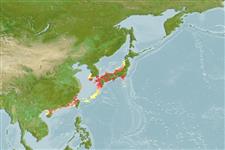>
Eupercaria/misc (Various families in series Eupercaria) >
Labridae (Wrasses) > Corinae
Etymology: Halichoeres: Greek, als, alis = salt + Greek, choiros = pig (Ref. 45335).
More on author: Günther.
Environment: milieu / climate zone / depth range / distribution range
Écologie
marin récifal; profondeur 0 - 4 m (Ref. 33416). Tropical
Northwest Pacific: known with certainty only from Hong Kong, Xiamen (China) and Taiwan.
Taille / Poids / Âge
Maturity: Lm ? range ? - ? cm
Max length : 13.6 cm SL mâle / non sexé; (Ref. 33416)
Épines dorsales (Total): 9; Rayons mous dorsaux (Total): 12; Épines anales 3; Rayons mous anaux: 13 - 15. Differs from H. bleekeri by having nearly always 14 pectoral rays (rarely 13 or 15); the presence of dark caudal spot on females; longest dorsal soft ray ranges from 2.25-2.4 in HL (Ref. 33416).
Inhabit exposed rocky reefs. Feed on amphipods and other benthic crustaceans (Ref. 128523).
Life cycle and mating behavior
Maturité | Reproduction | Frai | Œufs | Fécondité | Larves
Distinct pairing during breeding (Ref. 205).
Randall, J.E., 1999. Halichoeres bleekeri (Steindachner & Döderlein), a valid Japanese species of labrid fish, distinct from H. tenuispinis (Günther) from China. Ichthyol. Res. 46(3):225-231. (Ref. 33416)
Statut dans la liste rouge de l'IUCN (Ref. 130435)
Menace pour l'homme
Harmless
Utilisations par l'homme
Plus d'informations
RéférencesAquacultureProfil d'aquacultureSouchesGénétiqueElectrophoresesHéritabilitéPathologiesTraitementNutrientsMass conversion
CollaborateursImagesStamps, Coins Misc.SonsCiguateraVitesseType de nageSurface branchialeOtolithesCerveauxVision
Outils
Articles particuliers
Télécharger en XML
Sources Internet
Estimates based on models
Preferred temperature (Ref.
123201): 18.2 - 26.7, mean 22.9 °C (based on 145 cells).
Phylogenetic diversity index (Ref.
82804): PD
50 = 0.5000 [Uniqueness, from 0.5 = low to 2.0 = high].
Bayesian length-weight: a=0.00955 (0.00451 - 0.02020), b=3.09 (2.92 - 3.26), in cm total length, based on LWR estimates for this Genus-body shape (Ref.
93245).
Niveau trophique (Ref.
69278): 3.5 ±0.5 se; based on size and trophs of closest relatives
Résilience (Ref.
120179): Haut, temps minimum de doublement de population inférieur à 15 mois (Preliminary K or Fecundity.).
Fishing Vulnerability (Ref.
59153): Low vulnerability (10 of 100).
Nutrients (Ref.
124155): Calcium = 102 [57, 187] mg/100g; Iron = 0.739 [0.400, 1.445] mg/100g; Protein = 18.5 [15.7, 20.8] %; Omega3 = 0.129 [0.074, 0.220] g/100g; Selenium = 14.8 [8.0, 29.9] μg/100g; VitaminA = 171 [48, 679] μg/100g; Zinc = 1.91 [1.27, 3.13] mg/100g (wet weight);
